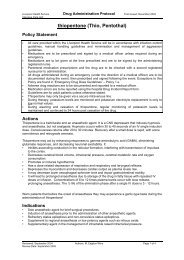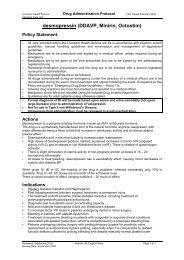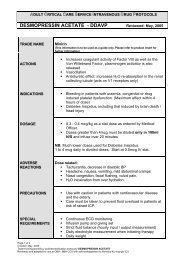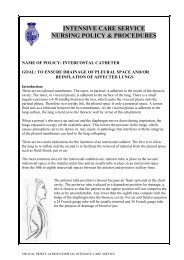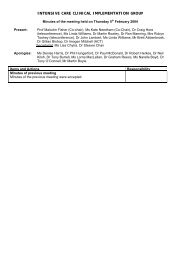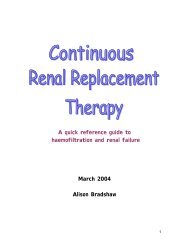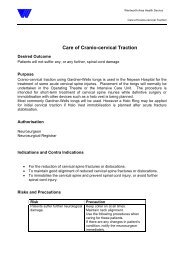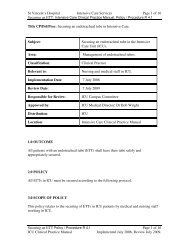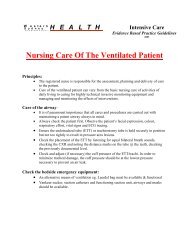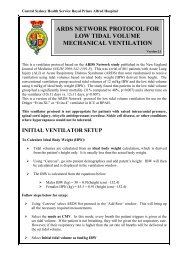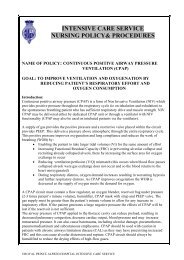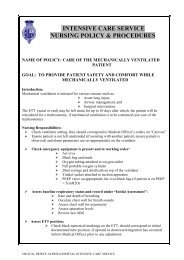Stabilisation of an Endotracheal Tube for the Adult Intensive Care ...
Stabilisation of an Endotracheal Tube for the Adult Intensive Care ...
Stabilisation of an Endotracheal Tube for the Adult Intensive Care ...
You also want an ePaper? Increase the reach of your titles
YUMPU automatically turns print PDFs into web optimized ePapers that Google loves.
Recommendations <strong>for</strong> Practice<br />
The purpose <strong>of</strong> <strong>the</strong> recommendations listed here is to in<strong>for</strong>m <strong>the</strong> development <strong>of</strong> local policy<br />
regarding <strong>the</strong> stabilisation <strong>of</strong> <strong>an</strong> endotracheal tube (ETT). The paucity <strong>of</strong> research literature<br />
regarding this topic has limited <strong>the</strong> ETT guideline development network’s (ETT-GDN) ability<br />
to <strong>for</strong>mulate specific recommendations regarding <strong>the</strong> optimal method <strong>of</strong> stabilisation <strong>an</strong>d<br />
related issues. There<strong>for</strong>e <strong>the</strong>se recommendations are considered to be <strong>the</strong> key principles<br />
that should be addressed when a clinici<strong>an</strong> is developing local policy.<br />
The decision to ch<strong>an</strong>ge or renew a patient’s ETT stabilisation method is influenced by several<br />
factors however must be made on <strong>the</strong> basis <strong>of</strong> ensuring <strong>the</strong> ETT remains in <strong>the</strong> optimal<br />
position. These factors may include:<br />
a. Is <strong>the</strong> patient’s ETT in <strong>the</strong> optimal position <strong>an</strong>d will it remain <strong>the</strong>re?<br />
If <strong>the</strong> ETT is in imminent d<strong>an</strong>ger <strong>of</strong> UEX or endobronchial intubation <strong>the</strong> clinici<strong>an</strong><br />
should prioritise correcting this.<br />
b. What is <strong>the</strong> patient’s current clinical status?<br />
Since <strong>the</strong> risk <strong>of</strong> UEX is heightened during <strong>the</strong> procedure if a patient’s clinical<br />
status is critical <strong>an</strong>d unstable ch<strong>an</strong>ging <strong>the</strong> ETT stabilisation method may not be<br />
warr<strong>an</strong>ted unless <strong>the</strong> ETT position is unstable.<br />
c. What is <strong>the</strong> patient’s level <strong>of</strong> consciousness?<br />
A patient who is restless, agitated or has <strong>an</strong> inadequate level <strong>of</strong> sedation is more<br />
likely to self-extubate (Boulain 1998) <strong>an</strong>d this risk will be increased when <strong>the</strong><br />
stabilisation method is being renewed.<br />
d. What is <strong>the</strong> impact <strong>of</strong> <strong>the</strong> ETT stabilisation method on <strong>the</strong> patient’s venous return<br />
from <strong>the</strong> head <strong>an</strong>d facial <strong>an</strong>d neck skin <strong>an</strong>d oral cavity?<br />
e. Has <strong>the</strong> method <strong>of</strong> ETT stabilisation been renewed within <strong>the</strong> past 24 hours?<br />
f. Is <strong>the</strong> method <strong>of</strong> ETT stabilisation consistent with unit guidelines?<br />
The recommendations <strong>for</strong> practice have been grouped under <strong>the</strong> following headings<br />
1. Clinical Govern<strong>an</strong>ce<br />
2. Choice <strong>of</strong> Method<br />
3. Patients with risk <strong>of</strong> raised intracr<strong>an</strong>ial pressure<br />
4. When to ch<strong>an</strong>ge ETT <strong>Stabilisation</strong> method<br />
5. Assessment<br />
6. General<br />
10




